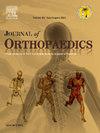A propensity matched cohort analysis: Cemented vs press fit humeral stem fixation in anatomic total shoulder arthroplasty
IF 1.5
Q3 ORTHOPEDICS
引用次数: 0
Abstract
Introduction
Historically, humeral stems were cemented for anatomic shoulder arthroplasty (aTSA). However, cementless, or press-fit, fixation has been increasingly used. This study aims to compare outcomes and revision rates between cemented and press-fit humeral stems.
Methods
Institutional records were searched to identify all patients who underwent aTSA with cemented humeral fixation or press-fit fixation between 2009 and 2021. A 3:1 propensity match based on age, sex, pre-op forward elevation and external rotation was conducted. Mean functional measurements were compared using a 2-Sample t-Test, ordinal variables via Wilcoxon-Mann Whitney test, and categorical variables via the Chi-squared test.
Results
There were 35 cemented humeral fixation shoulders matched with 105 humeral press-fit shoulders included in the final cohort. Both groups had similar characteristics at baseline regarding age, sex, body mass index, Charlson Comorbidity Index, mean follow-up, ROM, and strength measurements. Average age at surgery was 61.88 ± 6.68 years with an average follow-up time of 5.61 ± 2.86 years. Post-operatively, press-fit fixation demonstrated significant improvement in all ROM testing: external rotation (ER), forward elevation (FE), internal rotation (IR)-and all strength testing: ER, FE, and IR. Cement fixation demonstrated significant improvement in all ROM testing but only in FE strength testing. Inter-group post-op ROM and strength testing comparisons revealed superior external rotation (p = 0.007) and forward elevation (p = 0.047) ROM in the press-fit group with similar internal rotation ROM values and similar strength testing. There were higher revision rates in the cement fixation cohort (Cement: 11.4 % vs press-fit: 3.8 %; p = 0.036).
Conclusion
The results of this analysis showcase that press-fit fixation is a viable option for aTSA. Press-fit fixation shoulders had better ROM in terms of external rotation and forward elevation as well a better survival time to revision compared to cement fixation.
倾向匹配队列分析:解剖型全肩关节置换术中的肱骨干粘结固定与压合固定
历史上,肱骨干被用于解剖性肩关节置换术(aTSA)。然而,无骨水泥或加压内固定的应用越来越多。本研究的目的是比较骨水泥和压合肱骨干的结果和翻修率。方法检索机构记录,以确定2009年至2021年期间所有接受骨水泥肱骨固定或加压固定的aTSA患者。根据年龄、性别、术前前仰和外旋进行3:1倾向性匹配。平均功能测量值采用两样本t检验,有序变量采用Wilcoxon-Mann Whitney检验,分类变量采用卡方检验。结果最终纳入35例骨水泥肱骨固定肩胛骨与105例肱骨加压配合肩胛骨。两组在基线时在年龄、性别、体重指数、Charlson合并症指数、平均随访、ROM和力量测量方面具有相似的特征。平均手术年龄为61.88±6.68岁,平均随访时间为5.61±2.86年。术后,加压固定在所有ROM测试(外旋(ER)、前仰(FE)、内旋(IR))和所有强度测试(ER、FE和IR)中均有显著改善。水泥固定在所有ROM测试中均有显著改善,但仅在FE强度测试中有显著改善。组间术后ROM和强度测试比较显示,内旋ROM值和强度测试相似的压合组外旋ROM (p = 0.007)和前仰ROM (p = 0.047)更好。骨水泥固定组的翻修率更高(骨水泥:11.4% vs压合:3.8%;p = 0.036)。结论本分析结果表明压合固定是aTSA的可行选择。与骨水泥固定相比,加压固定肩关节在外旋和向前抬高方面有更好的ROM,并且在翻修前有更好的生存时间。
本文章由计算机程序翻译,如有差异,请以英文原文为准。
求助全文
约1分钟内获得全文
求助全文
来源期刊

Journal of orthopaedics
ORTHOPEDICS-
CiteScore
3.50
自引率
6.70%
发文量
202
审稿时长
56 days
期刊介绍:
Journal of Orthopaedics aims to be a leading journal in orthopaedics and contribute towards the improvement of quality of orthopedic health care. The journal publishes original research work and review articles related to different aspects of orthopaedics including Arthroplasty, Arthroscopy, Sports Medicine, Trauma, Spine and Spinal deformities, Pediatric orthopaedics, limb reconstruction procedures, hand surgery, and orthopaedic oncology. It also publishes articles on continuing education, health-related information, case reports and letters to the editor. It is requested to note that the journal has an international readership and all submissions should be aimed at specifying something about the setting in which the work was conducted. Authors must also provide any specific reasons for the research and also provide an elaborate description of the results.
 求助内容:
求助内容: 应助结果提醒方式:
应助结果提醒方式:


